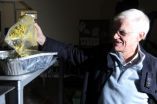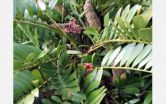(Press-News.org) On average we each consume 120 grammes of plastic wrapping on Christmas gifts most of which is of a type which is almost impossible to recycle. Now researchers at the University of Warwick have devised a new technique which could process 100% of Christmas and other household plastic instead of the tiny fraction that currently actually gets processed - typically only 12% of such waste is truly recycled often the rest is often put into land fill or simply burnt as fuel.
Some plastic still goes straight to land fill but householders currently spend a great deal of effort separating out the rest of their plastic waste believing it will be recycled yet typically only 12% of "Municipal Plastic Solid Waste" is truly recycled.
It is often simply too time consuming to separate out and clean the various types of plastic of their persistent labels or other problems, as that requires significant laborious human intervention.
An additional problem is that often objects are made of more than one plastic that would require different treatments.
However University of Warwick engineers have come up with a simple process that can cope with every piece of plastic waste and can even break some polymers such as polystyrene – back down to its original monomers (styrene in the case of polysterene).
The Warwick researchers have devised a unit which uses pyrolysis (using heat in the absence of oxygen to decompose of materials) in a "fluidised bed" reactor. Tests completed in the last week have shown that the researchers have been able to literally shovel in to such a reactor a wide range of mixed plastics which can then be reduced down to useful products many of which can then be retrieved by simple distillation.
The products the Warwick team have been able to reclaim from the plastic mix include: wax that that can be then used a lubricant; original monomers such as styrene that can be used to make new polystyrene; terephthalic acid which can be reused in PET plastic products, methylmetacrylate that can be used to make acrylic sheets, carbon which can be used as Carbon Black in paint pigments and tyres, and even the char left at the end of some of the reactions can be sold to use as activated carbon at a value of at least £400 a tonne.
This research could have a significant impact on the budgets of local authorities and produce considerable environmental benefits. The lab scale tests concluded this week have successfully produced distilled liquids and solids that can be taken away by the bucket load for processing into new products.
The University of Warwick engineers are now working with the University's technology transfer arm, Warwick Ventures, who expect that their work will be of great interest to local authorities and waste disposal companies who could use the technology to create large scale reactor units at municipal tips which would produce tanker loads of reusable material.
The lead researcher on the project, University of Warwick Engineering Professor Jan Baeyens, said:
"We envisage a typical large scale plant having an average capacity of 10,000 tonnes of plastic waste per year. In a year tankers would take away from each plant over £5 million worth of recycled chemicals and each plant would save £500,000 a year in land fill taxes alone. As the expected energy costs for each large plant would only be in the region of £50,000 a year the system will be commercially very attractive and give a rapid payback on capital and running costs."
INFORMATION:
full release online with picture and video at http://bit.ly/hzxoIO
For further information please contact:
Kevin Marks, Warwick Ventures
University of Warwick
Tel: +44 (0)24 7657 5491
Email: k.t.marks@warwick.ac.uk
or
Peter Dunn, Head of Communications, University of Warwick,
+44 (0)24 76 523708
mobile/cell +44 (0)7767 655860
p.j.dunn@warwick.ac.uk
PR173 14th December 2010
100 percent of most challenging Christmas plastic wrapping could be recycled by new tech
2010-12-15
ELSE PRESS RELEASES FROM THIS DATE:
The sweetness of biodegradable plastics
2010-12-15
Tel Aviv ― Environmentalists around the world agree ― plastic bags are choking our landfills and polluting our seas. Now a Tel Aviv University researcher is developing new laboratory methods using corn starch and sugar to help sustainable plastics –– those that biodegrade and are even tougher than those made from petrochemicals –– compete in the industry.
The answer to the problem, Prof. Moshe Kol of Tel Aviv University's School of Chemistry says, is a new variety of catalysts ― substances that initiate or sustain chemical reactions in other substances. ...
Fighter pilots' brains are 'more sensitive'
2010-12-15
Cognitive tests and MRI scans have shown significant differences in the brains of fighter pilots when compared to a control group, according to a new study led by scientists from UCL.
The study, published today in the Journal of Neuroscience, compares the cognitive performance of 11 front-line RAF (Royal Air Force) Tornado fighter pilots to a control group of a similar IQ with no previous experience of piloting aircraft. All the participants completed two 'cognitive control' tasks which were used to investigate rapid decision making. Diffusion tensor imaging (DTI), a ...
Environmental pharmaceutical contamination removed by Octolig
2010-12-15
An article in the current issue of TECHNOLOGY & INNOVATION, Proceedings of the National Academy of Inventors ™ http://www.cognizantcommunication.com/filecabinet/Technology/techinnovation.html reports on the removal of certain dyes and the antibiotic amoxicillin from water samples using Octolig ®, a commercially available material.
"Because of their properties and the magnitude of their production and use, pharmaceuticals can represent a serious disposal problem," said corresponding author* Dean F. Martin, PhD, of the University of South Florida's Institute for Environmental ...
2 people receive kidney transplants in pilot program using CMU software
2010-12-15
PITTSBURGH—A man in St. Louis and a woman in New Hampshire have received the first kidney transplants made possible through a new national program of the Organ Procurement and Transplantation Network (OPTN) that uses a Carnegie Mellon University computer algorithm to match transplant candidates with living donors.
Both recipients — Ken Crowder of St. Louis and Kathy Niedzwiecki of Pelham, N.H. — had loved ones who were willing to donate a kidney but who were medically incompatible with them. So, through a paired donation, Mr. Crowder's fiancée, Rebecca Burkes, donated ...
A protein called cFLIP makes tumor cells in breast cancer resistant to treatments
2010-12-15
Researchers at the Andalusian Institute for Molecular Biology and Regenerative Medicine (CABIMER) and the University of Granada found that cFLIP –an inhibitor of death ligand-induced apoptosis– is not only essential in breast tumor cells resistance to TRAIL treatments (a death ligand with a potent therapeutic potential against cancer), but this protein is also key to the survival of such cancer cells.
Researchers proved that a variation in the expression of this protein may lead to the normal development of breast epithelium. This is an important finding to be considered ...
Hubble spots a celestial bauble
2010-12-15
The delicate shell, photographed by the NASA/ESA Hubble Space Telescope, appears to float serenely in the depths of space, but this apparent calm hides an inner turmoil. The gaseous envelope formed as the expanding blast wave and ejected material from a supernova tore through the nearby interstellar medium. Called SNR B0509-67.5 (or SNR 0509 for short), the bubble is the visible remnant of a powerful stellar explosion in the Large Magellanic Cloud (LMC), a small galaxy about 160 000 light-years from Earth.
Ripples seen in the shell's surface may be caused either by subtle ...
What 'pine' cones reveal about the evolution of flowers
2010-12-15
From southern Africa's pineapple lily to Western Australia's swamp bottlebrush, flowering plants are everywhere. Also called angiosperms, they make up 90 percent of all land-based, plant life.
New research published this week in the Proceedings of the National Academy of Sciences provides new insights into their genetic origin, an evolutionary innovation that quickly gave rise to many diverse flowering plants more than 130 million years ago. Moreover, a flower with genetic programming similar to a water lily may have started it all.
"Water lilies and avocado flowers ...
Unique case study on Alzheimer's disease
2010-12-15
A case study from the Swedish medical university Karolinska Institutet sheds light on the pathological course of Alzheimer's disease. The brain of the first Alzheimer's patient to display amyloids demonstrable with a PET scanner has been studied, both during progression of the disease and after death.
One pathological characteristic of Alzheimer's disease is the accumulation in the brain of beta-amyloid proteins to form amyloid plaques. However, it is not known how early the plaques forms in the brain, whether they are the primary cause of the disease or what pathogenic ...
Violent games not to blame for youth aggression
2010-12-15
How depressed young people are strongly predicts how aggressive and violent they may be or may become. Contrary to popular belief, however, exposure to violence in video games or on television is not related to serious acts of youth aggression or violence among Hispanics in the US, according to new research by Dr. Christopher Ferguson from Texas A&M International University. His findings are published online in Springer's Journal of Youth and Adolescence.
The potential negative effects of violent video games on adolescent antisocial behavior, and youth violence in particular, ...
Drug use and discrimination among Phoenix area Mexican heritage youth
2010-12-15
Washington, DC, December 14, 2010—Perceived ethnic discrimination among Mexican and Mexican American students from Phoenix-area middle schools places them at risk for increased stress when trying to acculturate with mainstream U.S. culture, according to a new study. As the students experienced acculturation stress related to discrimination, they were at a higher risk for alcohol, cigarettes, and marijuana use. The study is in the December issue of Prevention Science, a peer-reviewed journal of the Society for Prevention Research.
"As levels of perceived discrimination ...



